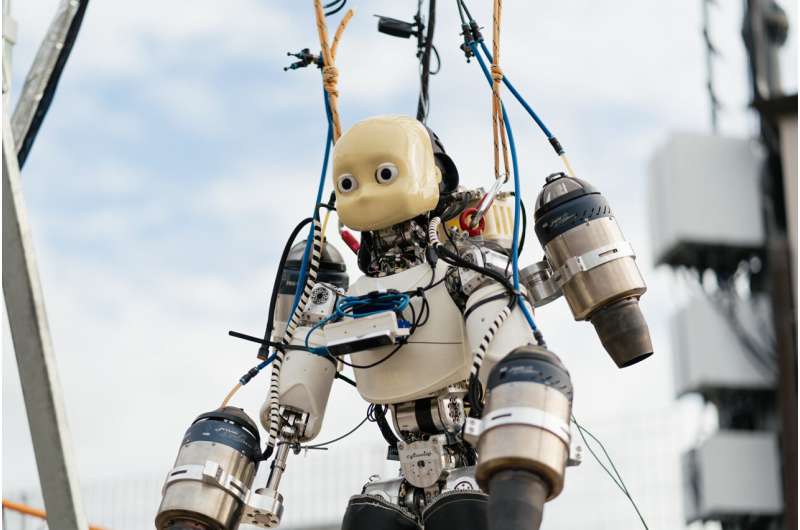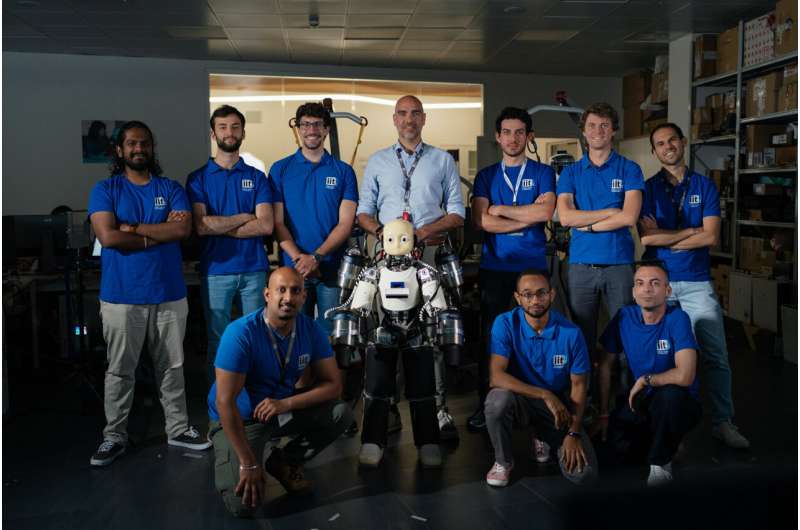
The Italian Institute of Technology (IIT) has achieved a remarkable feat in humanoid robotics by successfully making the iRonCub3 fly. This is the first-ever jet-powered humanoid robot that is engineered for real-world operations.
The research team meticulously examined the intricate aerodynamics of the robot and created a sophisticated control system for its interconnected parts. It took around two years to develop iRonCub3, which was able to rise about 50 cm off the ground while remaining stable during tests. This progress opens doors to future flying robots capable of functioning in complex environments while resembling humans.
The findings on aerodynamics and control have been detailed in a research paper in Communications Engineering.
This project was the result of collaborative efforts between IIT roboticists in Genoa and the DAER Aerodynamics Laboratory at the Polytechnic of Milan. They conducted a variety of wind tunnel experiments, and also partnered with Stanford University for the development of deep learning algorithms that helped in formulating aerodynamic models.
This flight demonstration marks a significant achievement for the Artificial and Mechanical Intelligence (AMI) Lab at IIT, led by Daniele Pucci. Their goal is to push the limits of multi-modal humanoid robotics to create machines that can walk and fly, particularly in rugged and challenging environments.
iRonCub3 represents a major technological advancement, as it’s based on the latest iCub humanoid robot (iCub3) and is teleoperated. It features a total of four jet engines—two on the arms and two on its back in a jetpack.
To accommodate the external engines, modifications were made to the iCub design, including a new titanium spine and heat-resistant covers. The robot, weighing about 70 kg, can generate over 1000 N of thrust, allowing it to hover and maneuver even in windy conditions. The engines can reach exhaust temperatures up to 800 degrees.
“This research marks a distinct departure from typical humanoid robotics, requiring us to leap forward in many areas,” says Daniele Pucci. “Thermodynamics is crucial here—the gases from the turbines can reach 700°C and flow nearly at the speed of sound. We must evaluate aerodynamics in real-time and create control systems that can manage both slow-moving joints and fast jet turbines. Testing these robots is both exciting and risky, leaving no room for errors.”
Focusing on the robot’s balance is key, especially given its human-like shape. Unlike traditional drones, which have compact designs, iRonCub3 has an elongated structure with weights distributed across its moving parts. This necessitated sophisticated balance models that consider its multi-body dynamics and how jet propulsion interacts with limb movements.
Additionally, the movement of its limbs adds another layer of complexity to its aerodynamics, altering with every twist and turn of the robot’s arms and legs.

The research group conducted extensive tests in wind tunnels and used Computational Fluid Dynamics (CFD) simulations, developing AI models that can assess aerodynamic forces in real-time.
“We’ve used neural networks trained on both simulated and real-world data, integrating these into the robot’s control system to ensure stable flight,” explains Antonello Paolino, the lead author of the study and a Ph.D. student in collaboration with IIT and Naples University, also having spent time at Stanford University.
Thanks to AI capabilities, iRonCub3 can fly while managing turbulent air, high temperatures, and the complicated nature of its multi-body dynamics.
The aerodynamic modeling created by IIT shows that iRonCub3 can maintain its balance and stability, even during complex maneuvers like starting and stopping its engines or adjusting its body shape.
This research can be extended to other unusual robot designs, offering a unique perspective compared to traditional drones that often depend on symmetry and simpler control systems that overlook their own aerodynamic and thermodynamic characteristics.
The design process for iRonCub3 has been thorough, combining the insights of aerodynamics and dynamics to create a truly innovative flying robot. Techniques have been employed to ensure optimal placement of the jet turbines to enhance flight control and stability. Moreover, these design improvements help manage heat from the engines, ensuring the robot remains intact even under extreme conditions.
The robot has undergone significant redesign to withstand the challenges of flight, focusing on accurate movement, better thrust control using integrated sensors, and advanced planning for coordinated takeoffs and landings.
The design process involved numerous iterations based on experimental results, which have allowed the team to surpass the limitations of conventional techniques and take a giant leap forward in developing complex robotic systems.
Initial flight tests of iRonCub3 occurred in IIT’s small testing area, where it managed to rise about 50 cm off the ground. In the coming months, testing will continue, supported by a partnership with Genoa Airport, which will provide a dedicated, safe area for future experimentation.
Flying humanoid robots like iRonCub3 could have diverse applications in the future, such as aiding in search-and-rescue missions in disaster zones, inspecting dangerous or hard-to-reach places, and exploration tasks that require both manipulation abilities and the option to fly.
For more information:
Antonello Paolino et al, Learning aerodynamics for the control of flying humanoid robots, Communications Engineering (2025). DOI: 10.1038/s44172-025-00447-w
If you would like to see similar Tech posts like this, click here & share this article with your friends!

